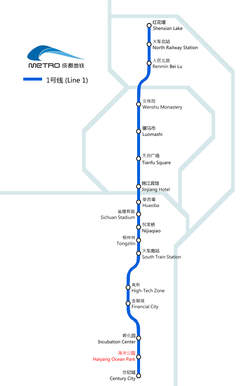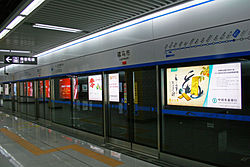- Chengdu Metro
-
Metro 
Info Owner City of Chengdu Locale Chengdu, Sichuan, China Transit type Rapid transit Number of lines 1 Number of stations 16 Operation Began operation 27 September 2010
(10 September 2010 Public Trial)Operator(s) Chengdu Metro Limited Technical System length 18.5km System map Metro Traditional Chinese 成都地鐵 Simplified Chinese 成都地铁 Transcriptions Mandarin - Hanyu Pinyin Chéngdū Dìtiě Chengdu Metro, commonly known as Metro in Chengdu, (Chinese: 成都地铁; pinyin: Chéngdū dìtiě) is a metro system in Chengdu, the capital city of Sichuan Province in China. It has one line, Line 1, which was constructed between December 2005 and 2010 (trial operation in March 2010 and formal opening on 27 September 2010). It is operated by Chengdu Metro Limited Liability Company. On September 27, 2010 Chengdu Metro was officially opened, making it the first all-Heavy Rail metro system in western China.[1]
Chengdu is in a tie with Shenyang as the 9th major city in the People's Republic of China to have a functioning metro system, after Beijing, Chongqing, Guangzhou, Nanjing, Shanghai, Shenzhen, Tianjin and Hong Kong.
Contents
Network
There will be five lines constructed in the first phase, covering 126 km with 116 stations including 11 interchange stations. Line 1 has 17 stations at along the 18.5 kilometre route, starting at Shenxian Lake and ending at Century City.
Color Line Terminals Opened Newest
ExtensionLength
(km)Stations Interchange Blue 1 Shenxian Lake - Century City 2010 — 18.5 16 — Line 1
The construction of the first phase of Line 1, costing 7 billion yuan, will change the city. One of the metro planners said the construction of the metro will change the layout of residential quarters in the city, with residential areas moving out to the suburbs.[2] A natural ventilation system has been used in the construction of the underground section of Line 1 on the subway system from Southern Third Ring Road to Chengdu New Exhibition and Convention Center. Square ventilation units are built every 30m along the subway top to allow fresh air from the ground enter the construction site underground. The method is used in subway construction in other countries as it cuts the construction cost and it saves energy. The subway system is the first in China to adopt such a ventilation system during construction. Chengdu Metro is planning to set up a section for subway fire control and introduce the latest fire fighting technologies and vehicles.[3]
Rolling stock and technology
There will be 22 sets of three cars each when the line opens, made by CSR. The trains will be air-conditioned and can hold up to a maximum of 1,200 people. The cars will be 2.8m wide and 19m long. In the future, trains will be expanded to five cars. The rolling stock's average train speed will be 35 km/h and its maximum speed will be 80 km/h. The metro system will be equipped with Automatic Train Protection, Automatic Train Control, Automatic Train Stop and Automatic Train Operation. Fire alarms, on-train/track systems, and automatic fare collection systems will also be installed. A minimum curve radius of 400m will be used where possible, though some restricted areas will have a curve radius of 300m. The maximum gradient will be 35% and the railway tracks will be laid to standard gauge (1435mm) using 60 kg/m rail, allowing a maximum speed of 80 km/h. The power supply will be 750V DC with third rail collection and running rail return.[4]
In April 2011, a further order was announced for trains from CSR, taking the total to 354 units.[5]
Network expansion
Seven lines are planned to be constructed over the next thirty years and five have been planned so far, with all around the city centre. When the whole of Line 1 is completed, it will have a length of 31.6 km with 22.44 km of underground tracks and 9.16 km of tracks at either ground level or elevated with 23 stations. There will be a depot at Huayang, two main substations, ten traction substations and one control centre. Line 1 will interchange with Chengdu North and Chengdu South railway stations.[4]
Lines under construction
- Line 2—From Longquan East to Shiniu (50.65 km; 26 stations)
- Line 3—From Hongxing[disambiguation needed
 ] to Banqiao South (49.28 km; 22 stations)
] to Banqiao South (49.28 km; 22 stations) - Line 4—From Wenjiang Technology Park to Xihe[disambiguation needed
 ] (38.9 km, 19 stations)
] (38.9 km, 19 stations)
Future lines
- Line 5—From Simaqiao to Jianghe (24.63 km; 13 stations)
- Line 6—From Shawan to Sihe (22.05 km; 13 stations)
- Line 7—From Shaxi to Longtan East (41.93 km; 22 stations)
References
- ^ http://www.chinadaily.com.cn/china/2010-09/27/content_11355596.htm, China Daily, 2010-09-27
- ^ Huang Zhiling and Bao Xinyan, Work begins on new metro schemes, China Daily, 2005-12-29
- ^ Chengdu Municipal Government, Subway to Adopt Natural Ventilation, Retrieved on 2007-03-13
- ^ a b Chengdu Metro Project, China, Railway Technology, Retrieved on 2007-03-13
- ^ "Chengdu Metro orders more cars". 2011-04-07. http://www.railwaygazette.com/nc/news/single-view/view/chengdu-metro-orders-more-cars.html. Retrieved 2011-04-08.
External links
- Chengdu Metro Official Website (Chinese)
 Rapid transit in the People's Republic of China
Rapid transit in the People's Republic of ChinaMRT & LRT In operationBeijing (Beijing • Beijing Suburban) • Changchun • Chengdu • Chongqing • Dalian (Dalian • Dalian Trams) • Guangzhou-Foshan (Guangzhou • Foshan) • Hong Kong-Shenzhen (Hong Kong • Shenzhen • Hong Kong LRT) • Nanjing • Shanghai (Shanghai • Shanghai Maglev • Zhangjiang Tram) • Shenyang • Tianjin (Tianjin • Binhai • TEDA Tram) • Wuhan • Xi'anUnder constructionPlannedChangzhou • Datong • Huizhou • Hohhot • Jiaxing • Jinan • Lanzhou • Quanzhou • Shijiazhuang • Taiyuan • Weifang • Wenzhou • Xiamen • Xuzhou • ZiboBRT In operationHangzhou • Beijing • Kunming • Changzhou • Xiamen • Jinan • Zaozhuang • Zhengzhou • Guangzhou • Dalian • Chongqing • HefeiUnder constructionShanghai • Shenzhen • Wuxi • Xi'an • Shenyang Transport in the People's Republic of China •
Transport in the People's Republic of China •  Rail transport in the People's Republic of ChinaCategories:
Rail transport in the People's Republic of ChinaCategories:- Rapid transit in China
- Transport in Sichuan
- Chengdu
- Proposed public transport in China
Wikimedia Foundation. 2010.


